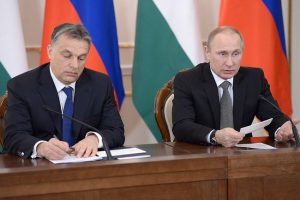Victor Orban and Vladimir Putin, 2014. Wikimedia Commons
By Silas Birdsell
Populism is an increasingly important aspect of domestic and international politics across the world. One region where populism is most deeply entrenched is Eastern Europe. Populist parties are the ruling party in seven nations–Bulgaria, Serbia, Bosnia and Herzegovina, Hungary, Slovakia, Poland and the Czech Republic–and in some nations, such as Hungary, both the ruling party and the main opposition party are populist parties. Dr. Balázs Trencsényi, Head of the Department of History at Central European University in Budapest, helped to provide historical and cultural context to the significance of populism in Eastern European politics.
In his talk, Dr. Trencsényi hypothesized that certain contexts are more likely to breed populist ideologies than others and that the tradition of “anti-political” history in Eastern Europe made the region especially prone to populism. Trencsényi has found that patterns of westernization, democratization and populist ideological development emerge throughout Eastern Europe’s history. Broadly, when states westernize they tend to democratize, leaving room open for opposing political views, and in this environment populist parties, which generally oppose the westernization and democratization processes, can come to power. Trencsényi noted that populist parties come to power through democratic means and behave the way you would expect political parties in a democracy to behave, but they do so while advocating a “third way” that is not only a rejection of traditional left and right political ideologies, but very often also a rejection of liberal democracy itself. Additionally, when populist parties do come to power they often steer their countries in more authoritarian directions (e.g. Poland’s dismantling of the independent judiciary). Trencsényi referred to these populist actions as the “hacking” of the public sphere.
Trencsényi also related Eastern European populism’s relationship to agrarian society. Populist parties in Eastern Europe are often best supported by rural communities and agrarian life is often evoked and celebrated by populist politicians. The centrality of agrarian society in the populist national image can be seen as a reflection of the postwar period in the Soviet Bloc, during which local communist governments manufactured coherent national identities where previously national ties had been multifaceted. East European leaders used peasant life and agrarian society as the foundations for forming nationalizing states during this period. Trencsényi stressed that Eastern European communist systems were more nationalist than often understood, helping to ensure that populism would survive in the region.
Trencsényi also discussed the ways in which populist parties and governments justify their right to rule. He highlighted five, not mutually exclusive styles of justification in which the populist party: claims to represent the “essence” of a nation (essence generally referred to the peasants or agrarian communities); seeks to bring about a “rebirth” of the nation, often recalling an idealized past; hierarchizes the people and claims to represent the masses; promotes nativism and claims to represent a particular ethnic group; or sacralizes the party through religious rhetoric and close ties with the church. He gave the example of Viktor Orbán’s regime in Hungary, which appeals to its supporters, in part, by constructing a narrative of a glorious past, a horrible present, and a messianic future. An important element of this narrative of rebirth is that Orbán’s regime sees continuity with the Kingdom of Hungary before the Second World War and sees its participation in the war as a member of the Axis powers and the subsequent People’s Republic of Hungary as periods of foreign control. Therefore, in Orbán’s rendering of the past, modern Hungarians are not responsible for the activities of the Hungarian government during the wartime and communist periods. Building on this example, Trencsényi concluded by examining the modern characteristics of Eastern European Populism. Eastern European populists in the 21st century are very often pro-Russian, ethno-nationalist, right-wing, anti-liberal, and anti-immigrant.
While Trencsényi contended that Eastern Europe’s context made its political system prone to populism, he cautioned against assuming that countries with different political and cultural contexts would not also be susceptible to populism. His presentation shed light on the history and nature of Eastern European populism and all those who attended left with a greater appreciation for the complexities of the region and its politics.
Silas Birdsell is a junior majoring in International Studies and Economics with a minor in Latin American Studies.

